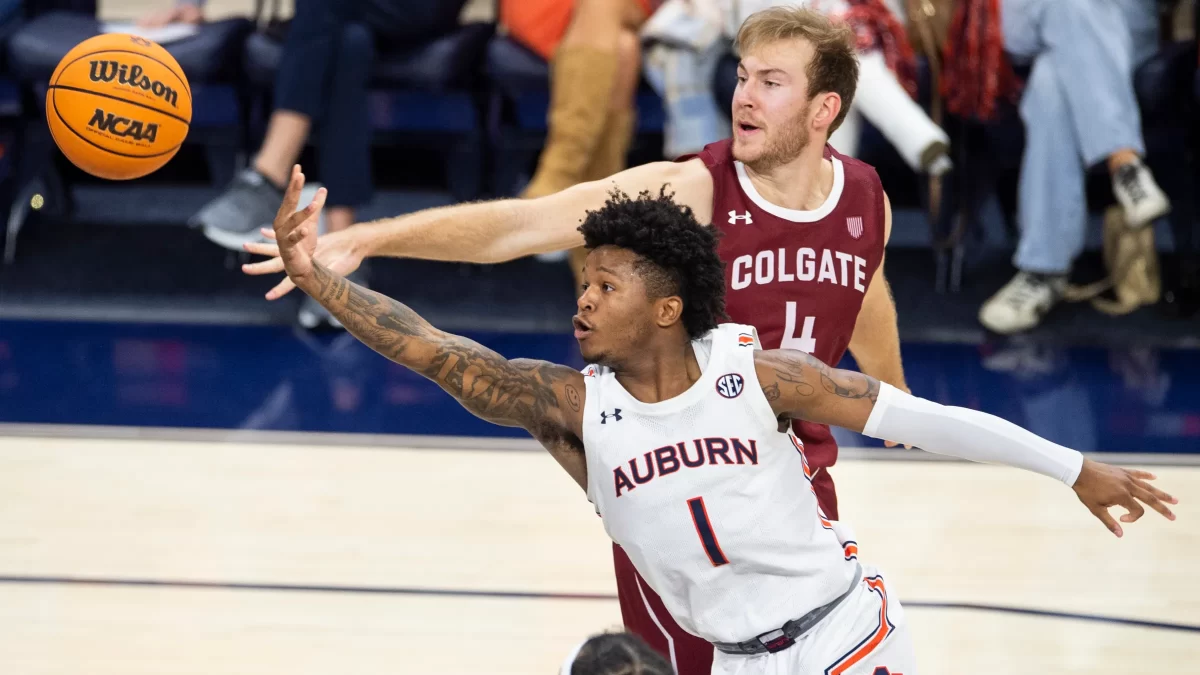You can probably break Arkansas’ 18-game SEC schedule up into three groups: acceptable losses, must-wins, and toss-ups. Looking over the schedule before conference play started, I identified two acceptable losses, 10 must-wins, and six toss-ups. The Hogs can go 0-2 in the first group, need to go 10-0 in the second, and can probably get away with 3-3 in third group. That should be enough for a 3-seed in March… or maybe a 2-seed if the Hogs also knock off Baylor in Waco and then do well in the SEC Tournament.
Here’s how I broke down the games. See if you agree:
- Acceptable Losses (0-2): at Alabama, at Tennessee
- Must-Wins (10-0): Mizzou, at Vanderbilt, Ole Miss, LSU, Texas A&M, at South Carolina, Mississippi State, at Texas A&M, Florida, Georgia
- Toss-Ups (3-3): at LSU, at Auburn, Alabama, at Mizzou, at Kentucky, Kentucky
Arkansas is already 0-1 in the toss-ups with that loss to LSU. But Kentucky is off to a bad start and it would not be shocking if the Hogs swept them, so getting to 3-3 is definitely doable.
I mention this because the second of the six toss-ups is on Saturday at Auburn.
Meet the Tigers
Bruce Pearl’s ninth Auburn team is difficult to figure out so far this year. Last year’s Tigers won the SEC but peaked way too early and faded down the stretch, losing in the Round of 32 against Miami.
Auburn lost star big men Walker Kessler and Jabari Smith, but brought back most of their backcourt. In the frontcourt, they added coveted Morehead State transfer Johni Broome. That was good enough to get them to the middle of the SEC pack in the preseason.

After a hot start that included a rout of a solid Bradley team, the Tigers are just 3-3 in their last six games. What is their best win? It’s not clear: maybe a road win over six-loss Washington, who also lost to Cal Baptist? Maybe a home win over seven-loss Florida, who also lost to Florida Atlantic? It’s probably that Bradley win on a neutral floor.

Our Resume Margin field is designed to grade the strength of each team’s win-loss record. By season’s end, it will almost perfectly predict the seed order of the NCAA field. As of now, it’s pretty close to the AP: the Hogs are 10th here and 13th in the AP (our model already includes the win over Mizzou, while the AP voted before that game), while Auburn is exactly 22nd in both (again, our model holds Auburn at 22nd despite that Georgia loss).
Model pick: Arkansas 69, Auburn 67. I tend to think it will be higher-scoring than this, because each offense has some advantages against the opposing defense, but it’s hard to say. Our model bakes in a 4-point homecourt advantage, but Auburn Arena is worth at least that. It’s a tough place to play.
One thing that jumps out from this is that Momentum number for Auburn, which compares team grades during their last six games versus the entire season. The Tigers are trending in the wrong direction, which makes sense given their win-loss results. Here’s how they’ve graded in every game:
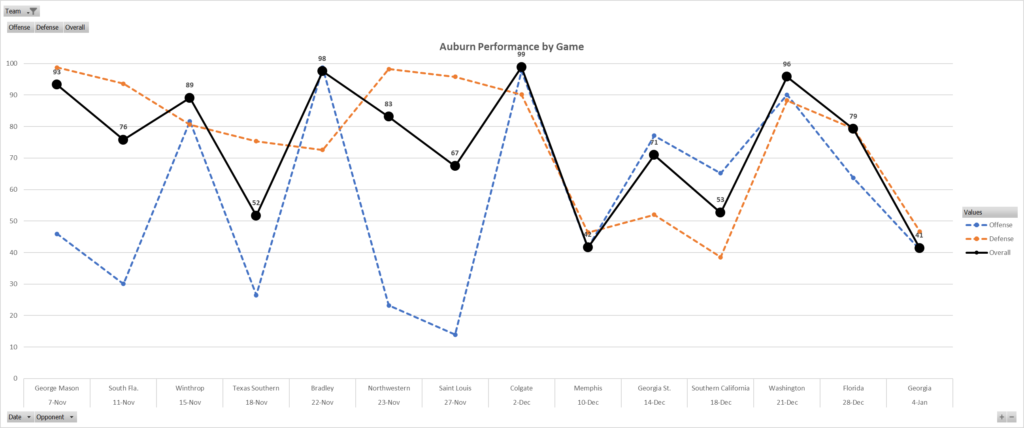
Auburn only graded worse than 70 in two of their first eight games, but now they’ve been below 70 in all three losses. Even their wins over Georgia State (71) and Florida (79) were not overly impressive.
In particular, you can see that their defense (orange) has let them down: after grading at 70+ in each of their first eight games, they’ve graded below 50 in all three losses and were at just 51 against Georgia State. Offensively, they’ve been all over the place and have actually become more consistent in recent games.
The daily ratings (since Thanksgiving) also tell the story:
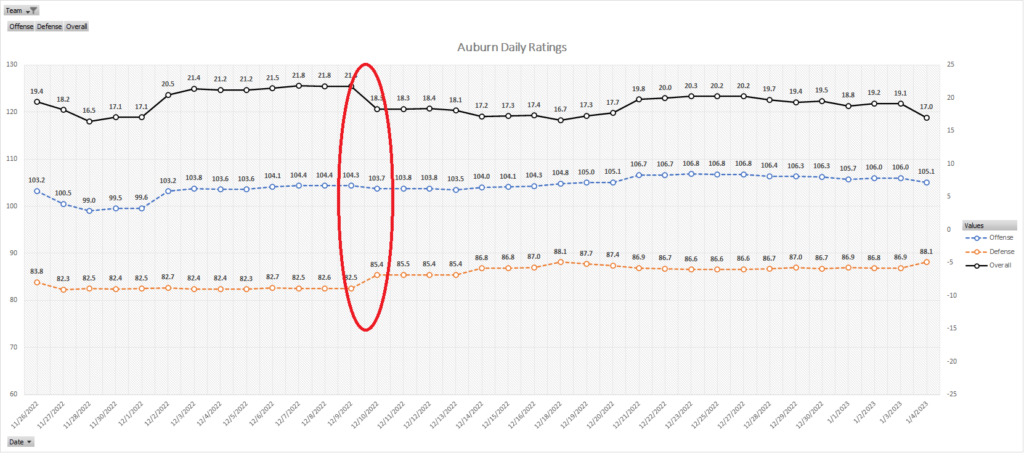
At Thanksgiving, Auburn had an Adjusted Defensive Efficiency of 82.5. Their December 10th loss to Memphis (circled) caused a jump up to 85.4 and it’s been trending the wrong way ever since, sitting now at 88.1 after the loss to Georgia. That means Auburn is about 4 points per game worse on defense now than they were on Thanksgiving Day, while their offense is basically the same.
We’ll dive into what went sideways for the Tigers and how well-equipped Arkansas is to exploit Auburn’s weaknesses.
Scouting Report
Schematically, these two teams are very similar to each other on both sides of the ball. They’ll both be attacking the same weaknesses with the same strengths.
Typical of a Bruce Pearl team, Auburn plays very fast on offense with good spacing to showcase their athleticism. Unlike a typical Bruce Pearl team, this one struggles from beyond the arc, so they look a look like Arkansas in that they want their guards to get downhill and get close to the rim. They crash the glass and draw fouls but have some turnover issues.
Their defense is excellent, thanks to one of the nation’s best perimeter defenses. It’s a typical man-to-man scheme, not allowing open 3-point shots and forcing turnovers on the perimeter. They want to force tough 2-point shots inside the arc… but their defense is merely good around the rim, not elite. They foul too often and can be victimized on the offensive glass.
Johni Broome, C, 6’10
- Box Score Contribution: +4.3 (3rd)
- RAPM: 63 (8th)
- Offense RAPM: 46 (8th)
- Defense RAPM: 74 (7th)
Auburn’s prized transfer is a conundrum. He’s a stat stuffer: his 29% usage is tied with Wendell Green for highest on the team, so they will get him the ball. He leads the team in scoring (13.1) and rebounding (8.7) per game. But he’s dead-last among regular rotation players in RAPM, meaning simply that he does not make Auburn better by being on the floor. We can compare him to Makhi Mitchell: he has a worse EFG% (51% to 65%), worse free throw to field goal ratio (0.31 to 0.34), lower assist rate (7% to 9%), higher turnover rate (16% to 15%), and equal defensive rebounding rate (both 24%). On defense, Broome has a DRAPM of 74 and Mitchell is at 76. They are basically identical players, except that Mitchell is an un-hyped role player and Broome was supposed to be the guy to replace both Smith and Kessler.
Broome rebounds well at both ends and blocks a lot of shots but is also frequently late to react to the ball entering the paint. On offense, he often looks out of place in Auburn’s scheme. He’s best on putbacks and decent on post-ups, but his attempts to create his own shot have had mixed results, and Auburn doesn’t get good offensive movement when he’s controlling the ball.
Wendell Green Jr., PG, 5’11
- Box Score Contribution: +1.9 (5th)
- RAPM: 96 (4th)
- Offense RAPM: 72 (4th)
- Defense RAPM: 99 (2nd)
Green is the other ultra-high-usage Tiger, also sitting at 29% usage rate. When Broome and Green are out there together, they combine to take about half of Auburn’s shots. Green facilitates the offense well, leading the team with a fantastic 22% assist rate. He also lives at the free throw line, where his 0.55 free throws per field goal attempt is crazy for a short guard. But if you can defend him without fouling, he becomes an offensive liability, as he’s a poor shooter (42% EFG) who turns it over way too often (24%). Defensively, he’s an excellent perimeter defender, like most of Auburn’s guards.
Jaylin Williams, SF, 6’8
- Box Score Contribution: +4.7 (1st)
- RAPM: 96 (3rd)
- Offense RAPM: 63 (5th)
- Defense RAPM: 99 (3rd)
The only player left in the SEC by that name, Auburn’s Williams is a jack of all trades. His main contribution is his defensive length. He’s a capable perimeter defender who can also block shots and deflect passes. On offense, he’s a moderate-usage wing who is good enough as a 3-point shooter to draw attention. He also doesn’t turn it over much and is above-average on the offensive glass.
KD Johnson, PG, 6’0
- Box Score Contribution: +0.3 (7th)
- RAPM: 66 (7th)
- Offense RAPM: 61 (6th)
- Defense RAPM: 65 (7th)
After starting 31 games a year ago, Johnson now comes off the bench. He will run point when Green is out and will be an off-ball shooter when Green is in. He’s similar to Green in many ways: lots of 3-point shots and free throws (so he’ll either spot up or drive when he gets the ball). Like Green, he turns it over too much (19%) and isn’t a great shooter (42%). The main difference is that he grades as a much worse defender than Green, hence his lesser role.
Allen Flanigan, SG, 6’6
- Box Score Contribution: +0.4 (6th)
- RAPM: 74 (6th)
- Offense RAPM: 52 (7th)
- Defense RAPM: 90 (5th)
The pride of Little Rock Parkview, Flanigan has been a thorn in the Hogs’ side for years. He spaces the floor well for the Tigers, but as an actual scorer he’s not very efficient. His shooting percentage is poor (49%) and he’s the most turnover-prone player (26%) on a turnover-prone team. He is a good perimeter defender who uses his length well.
Chris Moore, SF, 6’6
- Box Score Contribution: +2.9 (4th)
- RAPM: 87 (5th)
- Offense RAPM: 85 (3rd)
- Defense RAPM: 78 (6th)
The West Memphis product and onetime Arkansas commit has finally carved out a larger role for the Tigers, thanks to his offensive production on a team that sometimes struggles offensively. Moore is low-usage (15%) and doesn’t create much for himself, but he thrives when his teammates set him up. He shoots well (61%) on careful shot selection, gets a lot of offensive rebounds, gets to the line at a good rate, and doesn’t turn it over. Defensively, though, he’s had some issues, due largely to his very poor defensive rebounding for his size (just 8%), so the Hogs can crash the glass when he’s in there.
Zep Jasper, SG, 6’1
- Box Score Contribution: -0.4 (8th)
- RAPM: 98 (1st)
- Offense RAPM: 87 (2nd)
- Defense RAPM: 99 (1st)
Jasper’s stats are truly hilarious: he grades as the worst Tiger in terms of contributions to the box score, but the best in terms of how good he makes the team while he’s out there. There probably isn’t anyone in college basketball who has more “hidden” value than this guy. He’s out there for his defense, where he’s the best perimeter defender on a team full of great perimeter defenders. He’ll usually match up with the best outside shooter and stick to him like glue, preventing any shot from getting off. However, he won’t do much else. His 11% usage is extremely low. He shoots just 44% EFG, dishes out basically no assists (team-low 4%), and gets basically no rebounds (team-low 3% total and team-low 3% defensive). He’s there to defend.
Dylan Cardwell, C, 6’11
- Box Score Contribution: +4.5 (2nd)
- RAPM: 98 (2nd)
- Offense RAPM: 94 (1st)
- Defense RAPM: 96 (4th)
Cardwell is an interesting guy. He backed up Kessler last year and looked good in fairly limited minutes. He probably would have been fine as the starting center this year, but Auburn has handcuffed itself to Broome, so Cardwell – who seemingly makes Auburn a better team than Broome does – only sees the floor on 36% of team minutes. He’s shooting an other-worldly 81% from the floor and is a very good rebounder, tied with Broome in offensive rebound rate (16%) and trailing him only by a little bit in total rebound rate (19%). The main issue with Cardwell is that, unlike Broome, he’s not a shot creator at all and must be set up by teammates, hence his very low 12% usage.
When Auburn has the ball

Bruce Pearl’s teams tend to be very long and athletic, and this year’s team is no exception. The Tigers aren’t great on offense, but they will push the pace and get in transition. When confined to the halfcourt, they aren’t great. Arkansas’ transition defense has gone from good to elite over the last several games.

Auburn’s shot profile looks similar to Arkansas, and for similar reasons. The Tigers are struggling to make 3-point shots, so they’ve had to adjust their strategy. Pearl’s best teams tend to catch fire from beyond the arc, but this one hasn’t so far.
Instead, Auburn is going to attack the rim (41st in rim share). Shots there don’t actually fall at a great rate (94th), but they open the door for offensive rebounds (3rd) and free throws (19th). Teams that can keep them away from the rim tend to have the most success. That’s a bit concerning for Arkansas, as the Hogs are not particularly interested in keeping opponents away from the rim: Arkansas cares more about smothering the perimeter.
Here’s a pretty straightforward example of what Auburn does on offense. This was their first offensive possession against Georgia:

That’s Green missing an open 3 and Moore snagging two offensive rebounds and finally drawing a foul on the second. Typical stuff for the Tigers.
Here’s another one, where Green throws up a junk shot, probably knowing that his teammate (Williams) is going to go get it:

Johnson then drills that open 3 that was made possible by the offensive rebound.
That shot by Green can almost be treated as a pass in Auburn’s scheme. If the Hogs are going to shut down this offense, they have to deal with Auburn’s wings crashing in on shot attempts. Moore, Williams, Broome, and Cardwell are the big four in that department. They are always hovering, waiting for a putback chance.
When Auburn’s offense does stagnate, it looks a lot like Arkansas’ when it stagnates: off-ball movement basically goes to zero. Green is crafty with the ball and very dribble-happy, but sometimes his teammates just watch him dribble and wait for him to drive.
Here’s a good example from the Florida game. Auburn starts with a standard sequence: dribble handoff into drag screen for Flanigan. But once Flanigan comes off the screen, all off-ball movement ceases. Four Tigers watch as Flanigan barrels towards the rim with no plan:
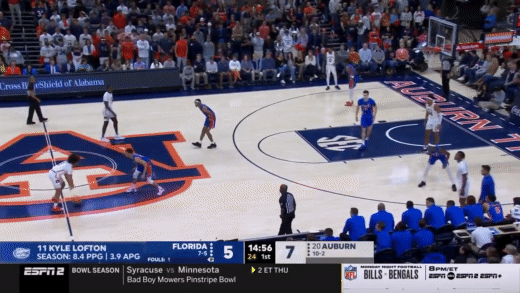
For Arkansas, contesting those dribble drives and boxing out are the two big keys. The Hogs would prefer to get the ball into the hands of turnover-prone guys like Flanigan while making more efficient scorers like Moore, Williams, and Cardwell non-factors. Since none of those three are good at creating their own shot, that’s a doable plan. If Auburn’s offense is just Green and Flanigan dribbling around, the Hogs are in good shape.
When Arkansas has the ball

Auburn’s defense is definitely better than its offense and will be a challenge for the Hogs to crack. The Tigers’ turnovers on offense mean they give up too many transition buckets off turnovers going the other way, but if you get stuck in halfcourt against them, they are pretty good.
Arkansas has not run well in the last two games: both LSU and Mizzou beat the Hogs in transition points. Auburn is yet another opponent that is vulnerable in transition defense and solid in halfcourt defense. Can the Hogs finally start running?

Auburn has a very man-to-man defensive profile. It’s actually really similar to Arkansas’. The Tigers give up a ton of shots near the rim (334th) in exchange for shutting down the perimeter (37th in 3-point usage, 10th in 3-point FG%). Their ball pressure also forces turnovers at a decent rate (96th).
Of course, there are drawbacks to that strategy. Allowing lots of shots near the rim means they are vulnerable to fouls (245th) and offensive rebounds (182nd). In particular, their guards are not very tall, making them mostly useless when defending under the basket. That’s a potential issue against Arkansas’ tall guards, as there’s not much 5’11 Green or 6’1 Jasper can do against 6’7 Anthony Black.
Auburn is very vulnerable to basket cuts for two reasons: first, their guards are really focused on defending the perimeter and tend to let their man inside of them very easily; and second, Broome often appears unaware as the lowest help defender.
Those come together on plays like this way-too-easy Georgia lob:

Auburn’s aggressive man defense frequently takes Broome (or Cardwell) out of the lane altogether, allowing these backdoor cuts (Broome is defending Colin Castleton on the perimeter):
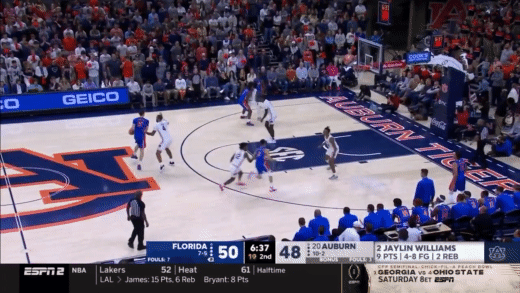
Cuts after the ball enters the post can succeed, too. Here, Green gets caught ball-watching and loses his man:

Georgia took half their shots at the rim, lived at the free throw line, and had a decent offensive rebound rate. That’s what Arkansas is built to do. Broome in particular had a rough night as a help defender, as he was late to help way too often for a rim protector. He’s averaging 3.4 blocks per game, but he’s had five total in Auburn’s last four games, which have come against more athletic competition. Against Georgia, Broome finished with 22 points and 12 rebounds… but Auburn was minus-17 with him on the floor, a sign that his non-statistical contributions (namely help defense) are lacking, a fact picked up in the RAPM numbers above.
If Auburn chooses to stick with their man-to-man defense, they are potentially in for a long game. Oklahoma’s “tough twos” defense was shredded by the Hogs, who happily made the contested paint shots that Oklahoma wanted to force.
I think Makhi Mitchell could have a good game, but if you want a surprise name (like Joseph Pinion against Mizzou), I’ll go with Jalen Graham. Graham is a good volume scorer around the rim. When Ricky Council is off his game, Arkansas doesn’t have any volume scoring. Graham can provide that. He turns it over too often and his defense is not as good as Mitchell’s or Kamani Johnson’s, but it’s possible that Graham could get the better of Broome in the post, which would cause Auburn all kinds of headaches. That makes this a potential juicy matchup for him. If Arkansas is struggling to hit contested shots with the guards, it wouldn’t surprise me if Graham got some key minutes.
Keys to the Game
- Cut, cut, cut! The Hogs have had a rough offensive start in SEC play, as their first two opponents successfully kept them away from the rim and forced more jump shots. Auburn’s not going to do that. The Tigers will let Arkansas inside the arc and try to contest shots there. The Razorback ballhandlers need to get downhill whenever possible, but off-ball guys need to be cutting to the basket instead of standing and watching. Auburn will freely help under the basket, which means off-ball cutters can get dump-offs and putbacks. Early cuts can lead to easy layups.
- Clear the defensive boards. On the flip side, Arkansas has to watch for Auburn cutters, who will trying to do the same thing against Arkansas’ man-to-man. Walsh and Mitchell are the two main guys who have to box out and rebound well, but Arkansas’ taller guards need to help against the Tigers’ long wings.
Thanks for reading! Be sure to follow us on Twitter and on Facebook.
The latest from Fayette Villains, straight to your inbox
Enter your email to subscribe and receive new post alerts and other updates. You can unsubscribe at any time.
